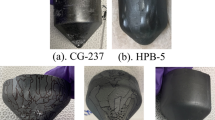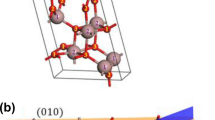Abstract
Based on an analysis of chemical diffusion of mercury in p-Cd x Hg1–x Te:As narrow-band solid solutions, a mechanism for conversion of the conductivity type upon ionic etching is suggested. It is shown that the n–p conversion of the conductivity in this case is due to the formation of a donor complex between arsenic in the Te sublattice and an interstitial Hg atom. Moreover, the electron concentration in the converted layer corresponds to the concentration of the implanted arsenic impurity. The theoretical results are confirmed by the experimental investigation of the electron concentration distribution over the n-layer of a p-Cd x Hg1–x Te:As epistructure converted upon ionic etching.
Similar content being viewed by others
REFERENCES
J. T. M. Wotherspoon, UK Patent No. GB 2095898 (1981).
M. V. Blackman, D. E. Charlton, M. D. Jenner, et al., Electron. Lett., 23, 978 (1987).
G. Bahir and E. Finkman, J. Vac. Sci. Technol., A7, 348 (1989).
V. I. Ivanov—Omskii, K. E. Mironov, K. D. Mynbaev, et al., in: Abstracts of Reports at the XII All-Union Conf. Semicond. Physics. Part 2 [in Russian], Kiev (1990), p. 205.
V. I. Ivanov—Omskii, K. E. Mironov, and K. D. Mynbaev, Fiz. Tekh. Poluprovodn., 24, 2222 (1990).
E. Belas, P. Hoschl, R. Grill, et al., Semiscond. Sci. Technol., 8, 1695 (1993).
A. V. Dvurechenskii, V. G. Remesnik, I. A. Ryazantsev, and N. Kh. Talipov, Fiz. Tekh. Poluprovodn., 27, 168 (1993).
E. Belas, R. Grill, J. Franc, et al., J. Cryst. Growth, 159, 1117 (1996).
V. Savitsky, L. Mansurov, I. Fodchuk, et al., Proc. SPIE, 3725, 299 (1999).
V. V. Bogoboyashchiy and I. I. Izhnin, in: Proc. 9th Int. Conf. Narrow-Gap Semicond., Berlin (1999), p. 30.
V. V. Bogoboyashchii and I. I. Izhin, Izv. Vyssh. Uchebn. Zaved., Fiz., No. 8, 16 (2000).
E. P. G. Smith, J. F. Siliquini, C. A. Musca, et al., J. Appl. Phys., 83, 5555 (1998).
J. F. Siliquini, J. M. Dell, C. A, Musca, et al., J. Cryst. Growth, 184/185, 1219 (1998).
J. Antoszewski, C. A. Musca, J. M. Dell, and L. Faraone, J. Electr. Mater., 29, 837 (2000).
V. G. Savitsky and O. P. Storchun, Thin Solid Films, 317, 105 (1998).
B. F. Ormont, Introduction to the Physical and Crystal Chemistry of Semiconductors [Russian translation], Mir, Moscow (1982).
P. I. Baranskii, V. P. Klochkov, and I. V. Potykevich, Semiconductor Electronics. A Handbook [in Russian], Naukova Dumka, Kiev (1975).
F. A. Kröger, The Chemistry of Imperfect Crystals [Russian translation], Mir, Moscow (1969).
K. R. Kurbanov and V. V. Bogoboyachshiy, Proc. SPIE, 3890, 528 (1999).
Author information
Authors and Affiliations
Rights and permissions
About this article
Cite this article
Bogoboyashchii, V.V., Vlasov, A.P. & Izhnin, I.I. Mechanism for Conversion of the Conductivity Type in Arsenic-Doped p-CdxHg1–xTe Subject to Ionic Etching. Russian Physics Journal 44, 61–70 (2001). https://doi.org/10.1023/A:1011312902981
Issue Date:
DOI: https://doi.org/10.1023/A:1011312902981




